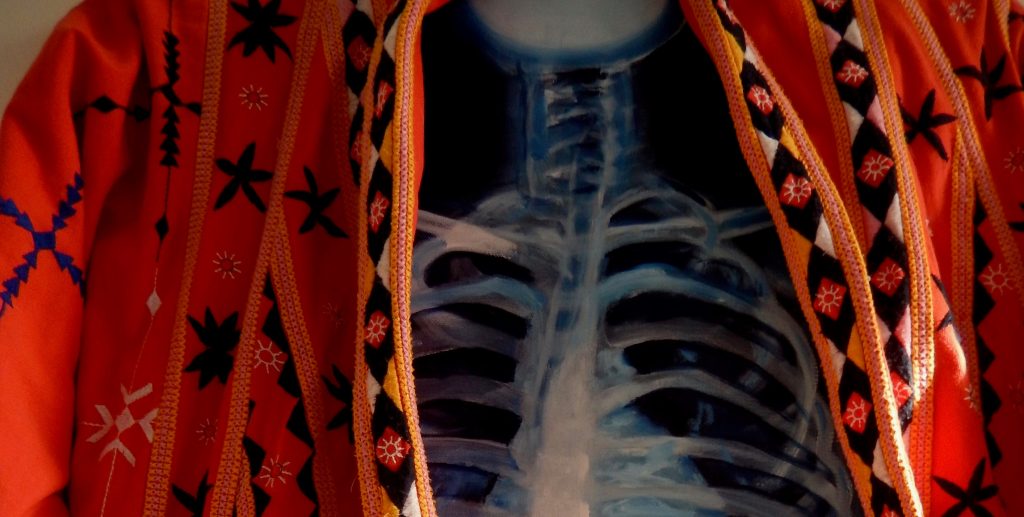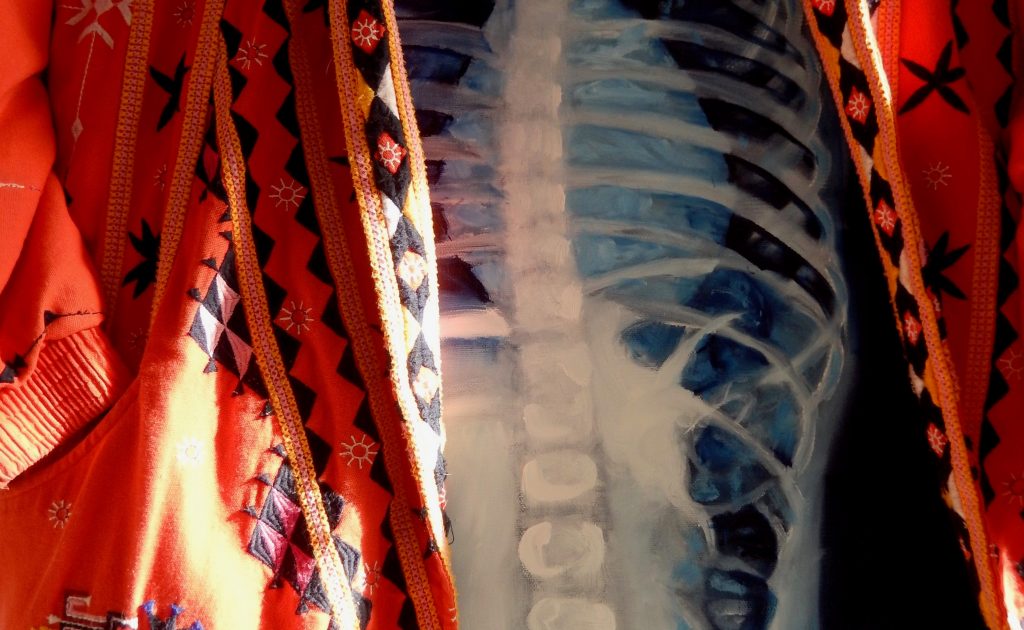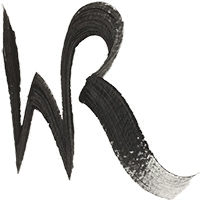
To Thine Own Self Be True; An Interview with Artist Wendy Rolt by Zoe Bowthorpe
We discuss the tensions between our society today and the internal landscape we carry that have inspired the latest exhibition from artist Wendy Rolt. As Rolt approaches her first solo exhibition, we talk about how it feels to curate this exhibition: To Thine Own Self Be True. Meeting in her East London studio, surrounded by canvas and wet paint, we look more closely at those tensions within and the creative force behind her latest exhibition pieces.
ZB: Many of these works deal with the problem of duality: that we try and separate the tensions in society today and in our interior response to these. What are the specific tensions that you look at in your work?
WR: I think that there are always tensions within us, whether it is our faith and beliefs and lived out experience, how we project ourselves on social media, our political stand, cultural norms and traditions, our upbringing or even our response to the environmental collapse happening around us.
As a Western culture we are taught not to think in paradoxes and to have a dualistic mindset so it becomes impossible to find a way to hold and carry tension in a healthy way. Many cultures, especially in the East, have a deeper understanding and reverence and respect for a non-dualistic mindset. Rather than defining elements as only one thing, for example a person or religion is good or bad, there is acceptance and understanding that there is light and dark in everything: there is always a tension as these co-exist but one does not cancel out the other. Both can be true.
This exhibition is an exploration and conversation between our internal and external selves. The works explore themes of exterior/ interior, thriving/ surviving, wanting/restraining, and ethical desires/real responses. How can we learn to hold both in our bodies without rejecting one? This is the experience of living: nothing is just one dimensional, there is often a tension within.
ZB: What lead you to decide on this exhibition now?
WR: I am daring to believe that what I create is worth sharing and will have resonance with others. As I engage with the tensions I have within myself I have made the decision that to be an artist is the deepest and healthiest means to express myself and a way to engage and respond to the present world I live in. We all have faith in different ideals, paths and elements; maybe I am putting my faith in this outlet right now.
Part of my own tension within has been leading to this point, and crossing this bridge: the desire for my work to be approved of and the pressure of being an artist who counts for something. I want my art to be relevant and to be part of the conversation that encompasses living in the city, often a manic urban life and witnessing London now. Having reached ‘middle’ age, I suddenly felt that it was time to fully embrace myself in being an artist.
ZB: Why does your work focus on this idea of tension within?
WR: To me it seems there is always a tension that is within, an internal and external dichotomy. We are of course products of our environment and mine is as a female in the inner city, volunteering and sharing life with those marginalized by society and vulnerable to their situations, as well as friends doing well in the financial sector and artists daring to believe in the value of art. I find plenty of sources to draw on in my environment that feed the content and subject of my work.
Acknowledging privilege and being fortunate is crucial to being open and aware of rather than living in pretense, but again there is always a tension of how to hold these dimensions in response to what is asked of you each day. I have come to hold Celtic wisdom and faith very closely, that there in a circular motion and a connection that flows between the natural world and life shared that goes beyond what we see and can be more beautiful and more real than the realities we see. We enter in and are part of it all. In being open and daring to hold tension I believe we become more aware of this connection.
ZB: There are mixed mediums in some of your works, such as the aluminium prints of MRI’s covered with jackets. What is the statement here?
WR: These pieces came about in response to the tension of our ultimate inner unseen self, covered by the exterior protection of fashion and money, seen mostly in social media and the image we chose to present to the world and the parts of our real selves we are prepared to block out so to be seen in a certain way. We cannot bring our whole selves to the foreground for fear of rejection but what is really left then? An MRI and a designer jacket?
This is also where the title of the show To Thine Own Self Be True resonates. We each have the mindset to choose what self we present rather than daring to find the non-dualistic way of accepting all of us, liking our whole self. The play of mediums using painting, photography and fabric opens the interpretation out to what is real, what is play and what is false? What is seen and what is withheld?
There are echoes of this dualistic being in the presentation of the feminine in the painting ‘Within, Without’.
She is a complex being with an outer and inner presence and presents us with a query of who she is.
There is the woman people want to see – the high heeled shoes, the lipstick, the looks – she is how we are told a woman should look if she is ´holding it together´. If she is successful she is winning. Of course the reality is the interior. The mess inside, a complexity of layers to sort through, but as long as she is holding it together on the exterior, everything is fine. This can be a particularly feminine trait – the appearance of a woman in control yet juggling so much and at what cost? There are frequent references to duality throughout art, literature, philosophy, but in this modern world right now, with such awareness of mental illness and of modern living pushing people to their limits, it seems especially prescient that we are all hanging on by a thread.
This particular painting was also inspired by the fictional character Eleanor Oliphant in the book by Gail Honeymoon, this character represents many of the tensions between what society asks of us and the reality of how we are able to respond to those and the consequences that can occur when we are unable to bring our true self into the picture.
ZB: The writings of John O’Donohue on Celtic Wisdom have been a strong influence in your work as well as poetry. How does your own poetry speak to your painting?
WR: Poetry has been another route towards creating works. Some of my paintings are birthed from the words I have written first. In poetry I have found the joy of being able to ramble and play freely with words and expression without worrying about clarity and understanding. It’s an outlet. My poems are certainly not written for people to read.

To thine own self be true: An interview with artist Wendy Rolt
ZB: You have had a lot of involvement as a volunteer with charities and 10 years ago you set up your own charity that focuses on assisting vulnerable women. The evidence of the traumas and also the reward of this work are evident in your work. How do you feel these experiences weave into what you feel you needed to express as an artist?
WR: In a position of privilege, which volunteering with charities can often be, I have learnt about my own vulnerabilities alongside with the resilience and utter determination of others. Seeing people at their most desperate embracing the determination to carry on and choose life is humbling, extraordinary and sometimes extremely emotional. And also walking closely with those when it is too much and everything collapses. The women I work with make me laugh and cry, we share all of the human emotions life has to throw at us as we try to work through the challenges together. But we each have our own path and our own barriers – and in sharing much of life I can’t help but be influenced by this and so it comes through in my art.
ZB: You previously worked on large-scale landscapes of places that were familiar to you and that you drew comfort from, such as Cornwall. This later departure into abstract and figurative work and, in particular, the theme of tensions seems like a personal transition in not just your work, but also your psyche. Is this your progression as an artist or just your journey in life?
WR: It is a transition and a leap of faith from my comfort zone into a deeper place of expression, especially to explore and purge the tensions within. I have stepped away from the concrete nature of painting what I see into figurative and conceptual art as I openly question what emerges in society locally and also more broadly and feel the discomfort and hypocrisy of how this relates to beliefs and values. This body of work represents trying to hold these tensions and contradictions while also practicing having a non-dualistic mindset in response. We are nurtured with ideas and values that we believe and hope to be true, and yet what we see around us can breach these comfort zones, normality and faith.
Maybe it is embracing our confusion and vulnerability that really makes us whole as humans. Weakness and suffering are part of the human condition that we all experience. There is no shame in it yet that is what is normally feel and what we respond to outwardly, so we hide. We step in and out of our own tensions. Each work in this show stems from the reality of tension; some are deeply personal while others are more ideas based. These can be as a woman dealing with my own feelings towards age and beliefs and desire as well as living an urban capitalist life in the full knowledge of the environmental collapse and knowing I am part of the problem and how do I hold knowing that with the decisions I make? The figures I have painted are wrestling with different themes, sometimes shown as having more than one head, in two minds yet one body, but all are external expressions of my internal and physical being response to holding tension. As the themes ripple out they cause the next creative response. I have come to learn from my physical body and my gut and senses and to let these steer my work rather than simply my head. In letting go of understanding, my work has become a place of holding truths that should not co-exist yet do, which is what life seems to so often be made of in an honest reality.
The Exhibition
To Thine Own Self Be True; The exhibition takes place 30th Sept – 4th October 2020, daily 11am – 6pm, weekends 11am – 4pm, at the Noho Showrooms, 67 Great Tichfield St, London W1W 7QA.
The Private View is September 30th 2020, 6pm-8pm, sponsored by Wiston Estate wines.
Late Night Showing is Friday 2nd September 2020, 6pm -9pm
